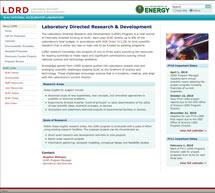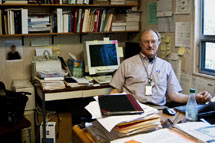
Handy Links
SLAC News Center
SLAC Today
- Subscribe
- Archives: Feb 2006-May 20, 2011
- Archives: May 23, 2011 and later
- Submit Feedback or Story Ideas
- About SLAC Today
SLAC News
Lab News
- Interactions
- Lightsources.org
- ILC NewsLine
- Int'l Science Grid This Week
- Fermilab Today
- Berkeley Lab News
- @brookhaven TODAY
- DOE Pulse
- CERN Courier
- DESY inForm
- US / LHC
SLAC Links
- Emergency
- Safety
- Policy Repository
- Site Entry Form

- Site Maps
- M & O Review
- Computing Status & Calendar
- SLAC Colloquium
- SLACspeak
- SLACspace
- SLAC Logo
- Café Menu
- Flea Market
- Web E-mail
- Marguerite Shuttle
- Discount Commuter Passes
-
Award Reporting Form
- SPIRES
- SciDoc
- Activity Groups
- Library
Stanford
Around the Bay
Lab Directed Research and Development Projects Awarded
When the Lab Directed Research and Development funds were distributed earlier this month, it marked the completion of what had been nearly nine months of deliberation for the program's organizers. Now, with the funds allocated and the researchers researching, they're looking toward next year's process.
The program, now in its third year, is designed to help deliver Department of Energy funding to new or high-risk projects that might otherwise go unfunded. According to LDRD Program Manager Steve Williams, the work is crucial to maintaining the tradition of innovative SLAC science.
"The LDRD program provides an open way to get ideas from almost any sector of the scientific community onto the table," Williams said. "It's very competitive, and it yields really high quality ideas."
So far, the program has directed $3 million to nine scientists for the 2010 fiscal year, with another $1.5 million yet to be distributed. According to Williams, the surplus is expected to be allocated in December.
In all, 46 proposals were submitted for consideration—a number that far exceeded expectations. The proposals went through an extensive review process, being evaluated on quality of science and how they contribute to the lab mission. The choice of projects to receive funding was intentionally diverse, ranging from studies into new uses for the PEP ring to explorations of electron behavior in atoms.
Accelerator design physicist Michael Sullivan received $75,000 in funds for his ongoing work to develop a design for the interaction region of the proposed SuperB collider. This is the second year that Sullivan has received LDRD funding for the project. He spent much of the first year coming up with different designs and trying to determine which one would be the most practical. This year he continues the effort, working closely with engineers to determine how best to bring the design into reality.
"It's a game of balancing the various constraints in order to get the most out of the design," Sullivan said. "You have to keep track of a lot of things."
Because the work is only in early stages, Sullivan has not been able to secure funding from other sources. If everything goes as planned, though, the work could help SLAC significantly expand its role in SuperB and other future collaborations.
"This is seed money to see if we can make this thing real," he said.
Astrophysicist Stefan Funk of the Kavli Institute for Particle Astrophysics and Cosmology was another LDRD awardee, receiving $323,000 to help design an ultra-fast camera for the proposed Advanced Gamma-Ray Imaging System. The camera would enable scientists to detect nanosecond bursts of light generated by gamma rays interacting with the earth's atmosphere, and could provide an unprecedented view of some of the most energetic events in the universe. Like SuperB, though, AGIS is still in research and development stages.
"So far, this is not a project that is funded on the national level," Funk said. "The LDRD money is absolutely crucial. It has made a big difference in what we've been able to do."
Other proposals focused more exclusively on SLAC science. For example, Linac Coherent Light Source laser scientist Bill White received $475,000 in LDRD funds to do research and design work on a next-generation laser that, if successful, could improve the coherence of the LCLS X-ray beam.
In the coming months, the LDRD team will reevaluate the submission process, and look at how it can be streamlined. The call for proposals for the 2011 fiscal year LDRD funds will go out around February 1, with a proposal deadline of May 1. For more information on the LDRD process, and for examples of previously accepted proposals, visit the LDRD Web site.
—Nicholas Bock
SLAC Today, October 22, 2009

